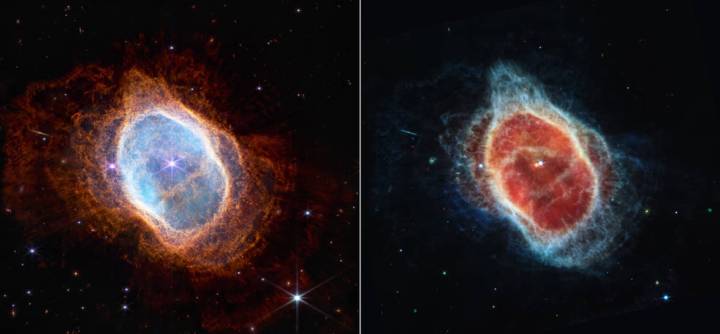NASA recently revealed the first high-resolution, color images from the most powerful space observatory ever built, the James Webb Space Telescope. And, peering into deep space farther than ever before, they didn’t disappoint.
A week on from that highly anticipated unveiling, the Canadian Space Agency (CSA), which along with the European Space Agency (ESA) is also part of the Webb telescope team, has posted a stunning video (below) that uses some video magic and Webb imagery to zip through space, taking us all the way to the Southern Ring Nebula, which is located 2,000 light-years from Earth.
WOW! 🤩 This video zooms through space to reveal @nasawebb’s image of the Southern Ring Nebula, 2000 light-years from Earth. Canada’s Fine Guidance Sensor allowed the telescope to point at and focus on its target.
Credit: NASA, ESA, CSA, STScI, and the Webb ERO Production Team pic.twitter.com/my5vbAjD80
— Canadian Space Agency (@csa_asc) July 21, 2022
The Southern Ring Nebula (below), is a thing of stunning beauty, its appearance the result of a dying star throwing off layers of dust and gas.

CSA’s Fine Guidance Sensor (FGS), which is part of the Webb observatory setup, is enabling the telescope to point toward and focus on its numerous targets.
“To make the most out of the Webb Telescope’s incredible capabilities, it was vital to design and build the most precise guidance sensor on any space telescope to date” CSA says on its website.
It explains that to enable Webb to bring targeted celestial bodies within its sights, the FGS sends relevant data to the observatory’s Attitude Control Subsystem, which uses the information to point the telescope toward the object of interest.
“To ensure Webb stays locked on its target, the FGS measures the exact position of a guide star in its field of view and sends adjustments to the telescope’s optical system 16 times a second,” CSA said.
The FGS is phenomenally accurate. Indeed, CSA says that the sensor is so sensitive that it can detect “a tiny angular displacement equivalent to the thickness of a human hair as seen from one kilometer away.” To give that some context, “that’s like spotting someone blink in Toronto, all the way from Montreal.”
The James Webb Space Telescope is now operating around a million miles from Earth. The $10 billion mission, which has been years in the making, is aiming to discover more about the origins of the universe while at the same time searching for distant planets that may support life. With its mission only really beginning in earnest in recent weeks, there is much to look forward to as the telescope is expected to make a slew of groundbreaking discoveries over the coming years.


